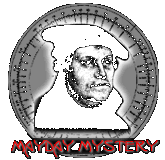
|
Delivery to my PO Box ~11 / 09ish / 2008
Contents: four cut pieces of paper with varying content. Nothing on the back of the paper ...
Delivery contents:
Click here to submit a clue for this page. Beacon The "Shade Tree mechanic" words are from the second verse of a Mark Germin song "Broken Man's Lament" popularized by Emmylou Harris. The nunbmers look like tables of random numbers except for the one at the bottom which is a Romberg's method triangular array for integrating the Gaussian function. http://en.wikipedia.org/wiki/Romberg%27s_method http://en.wikipedia.org/wiki/Gaussian_function The resulting Error function is is the probability that the error of a single measurement lies between two points say −a and +a, of a center of a normally distributed "bell" curve. To give an example say you assume that Irish terrorists are of "Catholic" and "protestant" backgrounds. Let us call them Republican and Loyalist. You assume each are sectarian and target the opposite denomination. They use a variety of bombs bullets and other methods. You expect one group to have more Protestant victims and another to have more Catholic victims. Sure enough you find one group killed about 60 per cent Protestants for 40 Catholics. But the other killed 85 Catholics for 15 Protestants. Now what are the chances that a 60/40 split happened just by accident (the "distance" of 10 from 50/50)? The chances of an 85/15 happening by chance alone (a distance of 35 which does not seem a lot more) are HUGE in comparison. By the way the figures I use are roughly correct http://cain.ulst.ac.uk/sutton/crosstabs.html crosstabbing "religion summary" and "Organisation summary" and looking at civilian targets in Northern Ireland and not military or police in uniform. So in this case you could get a measure of how probable it was that a terrorist group was targeting a particular religious denomination. bdh: dude. Kind of veered off there. Charlie P. 11.17.2008 Comments: The circled numbers are digits of pi: 96567 - 90,886th--90,890th digits of pi after the decimal 38543 - 92,481st--92,485th digits of pi 17463 - 92,696th--92,700th digits of pi The numbers in the third clipping are the results of applying Romberg's method (http://en.wikipedia.org/wiki/Romberg%27s_method) to a Gaussian function (http://en.wikipedia.org/wiki/Gaussian_function). We've seen Gauss before in the ads. The remaining text is the chorus of "Broken Man's Lament" by Emmylou Harris. Darren 11.22.2008 The two large pieces of paper are cut from the decimal expansion of pi. The highlighted 38543 appears at position 92,481 (not counting the initial "3."). The highlighted 17463 occurs at position 92,696 (although the digits "17463" do appear earlier in pi as well). The highlighted 96567 comes from position 90,886. The smaller triangular table of numbers is taken from the Wikipedia page on Romberg's method, under the "Example" heading: http://en.wikipedia.org/wiki/Romberg%27s_method The song lyrics are from "Broken Man's Lament" by Emmylou Harris. Mark 11.25.2008 Lyrics are from Broken Man's Lament by Emmylou Harris. The two pieces of paper with the 6 digit numbers are part of the sequence of pi decimals (see http://www.answerbag.com/q_view/133793 Pi to a Whopping 100 000 Decimal Places!). The rectangular piece of paper (0.77174333.....) is a Gaussian function integrated from 0 to 1 (the error function) accurate to 8 decimal places. See Romberg's method (http://en.wikipedia.org/wiki/Romberg's_method) and Error Function (http://en.wikipedia.org/wiki/Error_function) sjwk 12.07.2008 The two large pieces with 5 digit number sets are all from the first 100,000 digits of pi (http://www.wap.org/about/truemeaningofpi.html) The other piece contains the same number series given in the example on the wikipedia page for Romberg's method (http://en.wikipedia.org/wiki/Romberg%27s_method) Brian 02.12.2009 This may or may not relevant, but I thought I'd mention it anyways. Take a look at the beginning of the arch on the bottom. There's a group of numbers which were completely cut out. However, this is not the case with the rest of the numbers in the edge of the paper. The numbers are 53827. |
